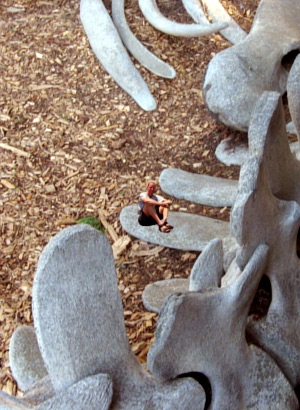UnNews:Moby Dick fossil found in Peruvian desert
| Democracy Dies with Dignity | ✪ | UnNews | ✪ | Monday, January 5, 2026, 11:49:59 (UTC) |
| Moby Dick fossil found in Peruvian desert | 
|
4 July 2010
LIMA, Peru -- Researchers making fools of them selves wasted no time in scanning the Peruvian desert for whale fossils and other fish bones. The media spared no mercy making fun of them, but the head researcher, Professor Jelle Reumer, had the last laugh when he stumbled upon the remains of a "sea monster" thirty times the size of a modern day killer whale, that is so large, it could only be the remains of Moby Dick.
The teeth of "Moby Dick" were so large it was initially assumed they were sun-bleached rib bones.
"There were no white whales in South America’s deserts before 3 million years ago, and the specimens found have an age of 12 to 15 million years, so that was totally impossible," said Professor Reumer, leader of the team of scientists who found the fossil in the Pisco-Ica desert in coastal Peru.
When asked, “what was totally impossible?” - Professor Jelle just turned and walked away. So there is no way to say what he was talking about.
They had been searching for other types of whale fossils in a remote area some 300 kilometers south of Lima. "The place where we found it was 20 kilometers from the nearest village, and far from the nearest water," said Reumer, who is also director of Natural History Museum in Rotterdam. “We now know for certain that fish and other sea monsters used to live in the deserts. But finding the remains of Moby Dick was beyond our wildest expectations!”
Strong winds had shifted sand to expose a thirty-meter long fossilized skull with the tiny skeleton of a human holding a harpoon tangled up in harpoon ropes – assumed to be Capt Ahab.
The skull of today's blue whale, still the largest animal ever known to have existed, is only around six meters long.
The fossilized remains found in Peru include a jawbone and a number of teeth, ribs and pelvis, each around 12 meters in diameter and up to 3 meters in length.
The size of its teeth indicate that the mammal fed on large prey, possibly baleen whales which were plentiful at the time of Dick’s existence around 12 million to 13 million years ago, in the middle of the Melvillien Age, Reumer said.
"It is not known why they became extinct." Reumer said it could have been due to "absence of water, or, possibly, sand suffocation.”
"After the time of Melville it became relatively much colder. At the same time the baleen whales became bigger probably to escape being caught up in the epic battle between Capt Ahab and Moby Dick, which was awesome! Another possible reason why the whales got bigger was to avoid being eaten by Moby Dick, just the way elephants escaped predation by becoming bigger so they were not scared by mice any more," he said. Baleen whales now grow to 30 meters in length. Back then; they were much smaller, around six to ten meters long. This was possibly due to their living so far from the sea.
Reumer says Moby Dick could be best compared to a humungous modern killer whale. Killer whales feast on sea lions, seals, fish, birds and sometimes other whales.
Modern sperm whales have a completely different method of feeding; they suck off squids at depths of a kilometer or more and only have relatively small teeth on their lower jaw.
The discovery was named after Herman Melville, the author of the novel Moby Dick.
The fossil will remain in Peru at the Museo de Historia Natural in Lima. 60 ton castings of the three largest teeth are on display at the Natural History Museum Rotterdam.
Reumer says there is very little chance another will be found. "There’s only one Moby Dick in all history!” he said.
The find is detailed in a paper published July 1 in the scientific journal Nature.
Sources[edit]
- Daily Mail Reporter "Monster of the Deep: Scientists find fossil skull of 43ft long whale which had 14in teeth". Daily Mail Online, July 4, 2010
